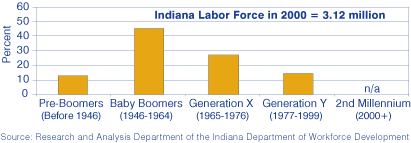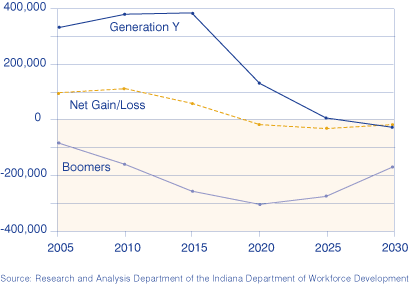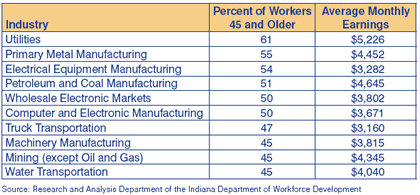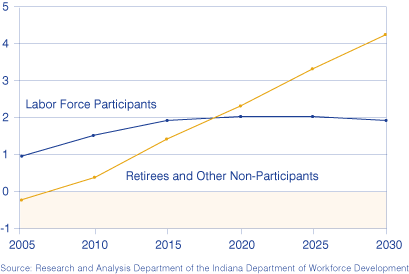Boomer Retirements in Indiana
Type the words “aging” and “workforce” in the Google search box. The outcome? Over one million results. The looming exodus of baby-boomers from the workforce into retirement has made the aging of the workforce a hotter topic than Indy 500 racer Danica Patrick (about 600,000 Google results). As the boomers approach retirement, here is what Indiana can expect.
The Generational Shift
In the year 2000, baby-boomers, those born between 1946 and 1964, composed 46 percent of Indiana’s labor force—the largest segment of all generational groups (see Figure 1). Other generational groups include Generation X, born between 1965 and 1976 (also known as “baby-busters”); Generation Y, born between 1977 and 1999; and the 2nd Millennium Generation, born in 2000 and after. By 2015, Generation Y, the youngest generation currently in the labor force, will compose 46 percent while the boomers’ retirements will decrease that generation’s share of the labor force to 27 percent. From now through 2015, Generation Y’s workforce numbers will increase faster than boomers retire.(1)
Figure 1: Percent of Indiana Labor Force by Generation, 2000

The boomers’ exit from the workforce will become most painful when 2020 arrives, as shown in Figure 2. By then, the number of boomer retirements will outpace the increase of Generation Y’s contribution to the workforce. Indiana’s workforce is projected to decline in total participants from 2020 through 2030 (see Figure 3). The average age of Indiana workers will have remained relatively stable, while the average age of those who have left the workforce will be increasing steadily. Between 2020 and 2030, the workforce will become younger, and those out of the workforce will be increasingly older (see Figure 4).
Figure 2: Projected Percent of Indiana Labor Force by Generation, 2020
Figure 3: Indiana Labor Force Gains and Losses, 2005 to 2030

Figure 4: Change in Average Age, 2000 to 2030
Vulnerable Industries And Occupations
The U.S. Census Bureau’s Local Economic Dynamics (LED) (2) program helps determine which industries would likely experience the heaviest and possibly the earliest impacts. Overall, Indiana’s industry employment is made up of 36 percent of workers age 45 and older (as of 2004). By 2020, the youngest of those will be 61—past the age of the early retirement options allowed for in many businesses and very close to the current average retirement age of 62 for women and 63 for men. The industries with the highest percentage of workers in this age group and with monthly wages above the state average are topped by utilities with 61 percent of the jobs held by those age 45 and above (see Table 1). Utilities also have one of the highest average monthly earnings for workers ($5,226 compared to the statewide average of all industries of $2,929).
Table 1: Percent of Workers 45 and Older by Industry, 2004

Amongst these “aging workforce industries” all but truck transportation is declining in employment, a decline that is expected to continue. (3) As one would expect, most of the occupations within the aging workforce industries are also on the decline.
There are four additional industries that should be noted as well—each is in the “top ten” in terms of employment of workers age 45 and older, each have average wages above the state average and each employ a greater percentage of older workers than the state average. Those four are transportation equipment manufacturing (42 percent, $4,207), hospitals (41 percent, $3,095), merchant wholesalers (40 percent, $3,884) and ambulatory health care services (39 percent, $3,820). Importantly, each of these industries has high employment totals today and is expected to grow. While previously mentioned industries may resolve some of the problem of replacing retiring workers via technological change or attrition, these four industries will have a pressing need to find ways to make up for the loss of older workers.
Occupations that would most likely be affected by the generational shifts due to their prominence in the aging workforce industries are a variety of occupations in engineering, electricity, health care, sales, maintenance and repair, production and transportation, and material moving. All of these areas have individual occupations that are both high paying and dominated by boomers.
Carrying Their Jobs in Their Saddlebags?
The good news for Indiana’s employers is that a sizeable number of the retiring boomers may not need to be replaced. Technology advances (in robotics, improved software products, etc.) and greater efficiencies will allow many businesses to continue operations with fewer employees in the future. Many of the industries and occupations most affected by the departure of the boomers are already considered declining in terms of their projected need for workers through 2012.
Another possibility is that the boomers will take their jobs with them by working as consultants for their former employers or continuing in a job-sharing mode, in order to supplement retirement income or retain partial benefits. Labor force participation has already increased over past experience for older workers. All age groups 45 years and older have higher participation rates today than in 1990, and all are projected to increase participation in the future. Studies have shown that the boomers, particularly those born after 1956, are less inclined to sacrifice consumer products and luxuries in retirement than was the case for the previous generation. This inclination drives them to keep working in some capacity. This tendency becomes even more likely if the intervening years bring changes to Social Security or Medicare that encourage longer workforce participation.
Notes
- Projections of the labor force from 2000 to 2030 were created by the Research and Analysis Department of the Indiana Department of Workforce Development. The projections were developed using U.S. Census Bureau population projections, U.S. Bureau of Labor Statistics labor force participation rate projections and the Indiana Department of Workforce Development’s Advanced Economic and Market Analysis Group labor force participation rate projections.
- Local Economic Dynamics program (LED) was created by a partnership between state labor market information agencies and the Census Bureau. It is designed to develop new information about local labor market conditions. More information is available at https://onthemap.ces.census.gov/.
- Indiana’s Industry and Occupational Projections 2002–2012 were produced by the Research and Analysis Department of the Indiana Department of Workforce Development.
Charlie Baer, Terry Brown, and Jon Wright, Labor Market
Analysts
Research and Analysis Department, Advanced Economic
and Market Analysis Group, Indiana Department of Workforce Development


